Introduction
Whilst having a relatively short production timeline of just three years and four months, there were many different iterations of the first Grand Seiko, with updates to numerous different features of the watch including the dial, handset, caseback medallion.
I will go over the production timeline of the different variants, along with a discussion as to their relative rarity, desirability, and pricing, in the context of an example of the first Grand Seiko that sold recently at auction.
Phillips Geneva Watch Auctions
It’s probably fair to say that out of all the major auction houses, it is Phillips’ watch department - to give it its full title, “Phillips in Association with Bacs and Russo” - that has established itself as the undisputed worldwide market leader in the watch auction business.
Over the last couple of years, it has been interesting to note that Phillips have started to include vintage Grand Seiko in their catalogues, most notably at their prestigious Geneva auctions.
Whilst clearly this has been a gradual process perhaps akin to dipping one’s toe into a hot bath to test the water temperature, if one were to take as a group the three vintage Grand Seiko references that have been sold at Phillips Geneva over the last 18 months, one can’t help but wonder whether there is a longer term plan afoot here, the beginnings of which have only just become apparent.
The three watches sold so far at Phillips Geneva are a 6186-8000 VFA (in the May 2021 Geneva Watch Auction XIII), a 4420-9000 (in the November 2021 Geneva Watch Auction XIV), and finally an example of the raised logo dialed first Grand Seiko (in the November 2022 Geneva Watch Auction XVI), which is pictured above.
The prices achieved for the watches - CHF44,100 for the VFA, CHF59,220 for the 44GS, and CHF20,160 for the “First” - were, for anyone who has been keeping a close eye on the wider market for vintage Grand Seiko over the years, extraordinary.
For the purpose of this newsletter, it is really only the price of the most recent watch sold - the first Grand Seiko - that is relevant, and more on that later. But there is one thing that becomes obvious when you look at the bigger picture.
Phillips Geneva have, over the course of three auctions, sold what is without any doubt in my mind, a perfect three-watch vintage Grand Seiko collection.
The most common question I receive from seasoned watch collectors who are looking at vintage Grand Seiko for the first time is not “what vintage Grand Seiko would you recommend I add to my collection?”, but “if I were to put together a small sub-collection of vintage Grand Seiko, what should be in it?”.
For a three watch collection, there really can only be answer - a “First”, a 44GS, and a VFA, and Phillips Geneva have sold an example of each of those iconic references - in reverse chronological order to their original launches - over the last 18 months.
Now, clearly there are many different options available when putting together this ideal three watch vintage Grand Seiko collection - most notably when it comes to choosing an example of the first Grand Seiko and a VFA. In featuring one of the most common VFA’s - the silver dialed 6186-8000, and the most common first Grand Seiko - the raised logo dial variant, Phillips Geneva have effectively established the baseline here.
I suspect there are probably quite a few collectors out there who are looking at what Phillips have been up to with vintage Grand Seiko - and perhaps with one eye on the upcoming New York auction, where there is an entire “chapter” dedicated to Grand Seiko, including three vintage pieces - wondering whether now might be a good time to dip their own toes into vintage Grand Seiko.
Well, in my view, there is no better time than the present, and no better place to start from than the beginning, so let’s take a look at what the options are for the first Grand Seiko.
The variants of the first Grand Seiko
The first Grand Seiko was available in a number of variants over the course of its lifespan. At the highest level of detail, the watch was manufactured in both filled gold and platinum cases (with possibly steel cased demonstration only watches for the platinum version). But more granularly, each of the filled gold and platinum cased variants had their own sub-variants, which typically are identified by specific aspects of their dials.
Broadly speaking, examples of the first Grand Seiko can be found with the “Grand Seiko” logo on the dial being printed, carved, or raised. Within those broad categories there are further nuances, which I will get into later.
The platinum cased watches are out of scope for this article, as I will be covering (and offering for sale) just the filled gold cased variants.
Launch
The first Grand Seiko was launched to the public on Sunday December 18th 1960. As is evidenced by the article in the March 1961 issue of Seiko News (a monthly magazine distributed to Seiko authorised dealers throughout the vintage era), the watch was clearly a huge success with the magazine making it evident that demand was far outstripping the initial supply.
“We are very happy to announce that the Grand Seiko 25-jewel, a top-quality Japanese-made product, has been well received by our customers. However, due to the large number of orders, we are currently experiencing a shortage of the product.”
Whilst in modern times Grand Seiko are keen to stress that the ethos behind the watch was - and I quote from their website - “… to build a watch that would be as precise, durable, easy to wear and beautiful as humanly possible”, back at launch, the message was rather more blunt -
“Challenging Switzerland’s finest domestic products. The finest domestic products.”
Production timeline - for the reference
Clearly if you are looking to launch a new product, you need to make sure you have sufficient quantities available to meet demand, so whilst it is common knowledge that the first Grand Seiko was launched on December 18th 1960, the watch had actually been in production for quite some time prior to that.
Seiko collectors typically will go by the serial number stamped on the caseback to date a watch. For vintage Grand Seiko, this serial number is most commonly found on the outside of the caseback, but for the first Grand Seiko - as seen on the above photo - it is stamped on the inside. This particular caseback serial number “0514445” allows us to date the watch to May 1960. The first two digits identify the year and month of production.
Having studied many hundreds of examples of the first Grand Seiko, I’m extremely confident in stating that - if we base our production timeline off the caseback serial number - the first Grand Seikos were manufactured in April 1960.
There is an important caveat here however, in that it is generally believed that the casebacks are stamped at the end of the production process. From looking at serial numbers of the movement in the watches (which do not match the case serial numbers), it would appear that several thousand movements had already been manufactured by the time the watches were assembled.
Indeed, the highest numbered movement I have seen in a first Grand Seiko whose caseback serial number indicates production in April 1960, is 604554. Whether or not movement serial numbering is unique and contiguous to a caliber I do not know, but the lowest serial number for a movement I have ever seen is 600045, so it’s probably safe to assume they started at 600001.
As for the latest watches that I have seen, these date to August 1963 (with case serial numbers starting 38), giving us a total production time line - at least with respect to final watch assembly - of three years and four months. Interestingly, August 1963 is also the earliest production date that we find for the successor to the first Grand Seiko - the Grand Seiko Self-Dater.
Production timelines - for the variants
A study of movement and case serial numbers (where visible) for every example of the vintage Grand Seiko to have come to market over the last decade has enabled me to put together a detailed timeline of exactly which variant was in production when.
As is always the case with vintage Seiko, there are no hard and fast cut-off dates when one variant ceased production and was replaced by another. Rather, as we can see from the table below, there are always overlaps as one variant is phased out of production, and another brought in.
The table above details what I consider to be the next level of breakdown beyond the standard “print, carved, raised” logo structure that is typically referred to in the modern marketing material.
Whilst this level of breakdown can be taken one step further (there were different methods used for carving the logo into the dial, and also different methods for applying or embossing the raised logos), it will suffice for the purposes of this article.
Print logo
Today, Grand Seiko will tell you that the Print logo dialed watches came first, followed by the carved logo dials. However, one look at the timeline above will immediately indicate that this is not the case.
I have details of around three dozen watches originating from the first quarter’s production, and both print and carved dial variants can be found in each month within the quarter, with (genuine) printed logo dialed watches only originating from this quarter, and the carved logo examples from the same period outnumbering them by roughly 2:1.
It is entirely possible that all the print dials were manufactured before a decision was made to change to carved dials, but the utilisation of the print logo dials in assembled watches is pretty much random over the course of the first three months of production.
Carved logo
Whilst there are clearly different methods by which the logo was carved into the dial - with some, such as the above example, looking to have been carved by hand with a sharp edged tool that created a ‘v’ shape to the carving, and others, such as the example below, looking to have been engraved using a machined tool resulting in a “u” shaped indentation - it is challenging to break these methods down to individual timelines.
What can be more clearly differentiated is the move from a two-piece index at 12 o’clock (as found on all print logo dialed watches) to a single-piece index, as seen below -
These two images are to scale, and as can be seen, the earlier two-piece index on the left is wider and shorter than the later single piece index on the right.
Since we typically will think of an index as a single point of detail, I have come to refer to these as the “split 12” and “single 12” indices.
In addition to having a database containing the details of all watches where I have knowledge of movement and/or case serial numbers of, for the purposes of this article I also took a look at every single first Grand Seiko to have been listed on Yahoo Japan Auctions over the past decade.
In each dataset (approximately 200 watches with serial numbers in my database, and around 500 in the Yahoo historical listings), the single 12 index carved logo dialed watches outnumber the split 12 ones by approximately 2:1. This may seem odd at first given the broadly similar number of months each was in production for (8 months for the split, 10 for the single), but I will return to this later.
Transitional variants
Mid-1961 saw probably the most significant change in the production history of the first Grand Seiko, with a change from carved logo dials to “raised” ones. For a brief few months, we can find “transitional” watches.
Print and regular carved logo dialed watches have a dial code GSJ14H156. The regular raised logo dialed ones have a dial code GSJ14H156E SD. The transitional pieces fall between these two, with a dial code of GSJ14H156E.
Whilst all having the same dial code, I have seen examples the following examples - carved logo with “mountain” handset; carved logo with flat handset; raised logo with flat handset.
It’s probably fair to say that right now, from the perspective of collectors, these transitional variants are more of historical intrigue than something to chase after, but who knows, perhaps that may change in time!
Raised logo SD dial
With production commencing in June 1961 and running all the way through to August 1963, the raised logo variant of the first Grand Seiko is by far the most common to be found, and it is an example of this watch, pictured below, that was sold at Phillips Geneva auction in November of this year for CHF 20,160 -
With the raised logo dial watch being in production for 27 out of the 41 months that the first Grand Seiko was being made, you might be forgiven for assuming that approximately two thirds of all examples of the reference we see today would have raised logo dials, but you’d be a long way off.
Having checked every completed listing on Yahoo Japan Auctions over the last decade (and that was a laborious task, I can tell you!), it transpires that no fewer than 85% of those watches are the raised logo variant.
More on the relevance of this later, when I will discuss relative rarity and pricing of the different variants.
Raised logo AD dial
The final variant of the first Grand Seiko to be manufactured is the “AD” dial variant. As should be obvious from the above image, the dial on this watch is completely different to all other versions, featuring a sunburst, rather than matte, finish.
It is an extraordinarily rare watch, and I have only ever been able to find examples from two manufacturing months - May and August of 1963 - where it was produced alongside vastly more examples of the regular raised logo SD dial watch.
The first Grand Seiko - relative rarity, desirability, and pricing of the different variants, and sets
Since I started collecting vintage Grand Seiko in 2016, the demand for the watches has increased substantially.
Naturally much of this is down to the significant investment made by Grand Seiko in recent years - particularly since the rebrand in 2017 - taking the brand truly global and “independent” from the parent company; establishing Grand Seiko companies in territories around the world; leading to the creation of a network of both brand-owned boutiques, and the GS9 owners clubs.
The marketing spend has clearly gone through the roof, with sponsored “advertorials” and paid-partnership features appearing on influential websites and social media accounts, and a significant ramping up of promotional events.
Whilst of course primarily directed at driving sales of the current range of modern watches, there is no doubt that - and this is especially evident since the 60th anniversary of the brand in 2020 - there is an increasing focus on communicating the history of Grand Seiko, with a strong emphasis on promoting the importance of the vintage pieces.
At the recent event in London to commemorate the launch of the new boutique on New Bond Street for example, several vintage pieces were on display alongside modern pieces as staff on hand highlighted the direct connection between watches in the current range and the historical references from the 1960’s and 1970’s.
This has culminated in something that I suspect not many people will be aware of.
Grand Seiko themselves now sell vintage Grand Seikos.
The watches above were available for purchase from the Wako department store in Tokyo on my recent visit in October, displayed as part of a permanent exhibition on the second floor of the store that showcased the history of Grand Seiko.
And yes - that is a raised logo dialed first Grand Seiko, with a price tag of 2,585,000 Yen (or almost $19,000 at today’s exchange rate), and the prices on the other references were commensurate.
Every one of those watches pictured above has been purchased since my visit.
In addition to that, the “Grand Seiko Chapter” at Phillips’ The New York Auction: SEVEN, taking place on December 11th, features no fewer than ten lots dedicated to Grand Seiko, with three of the lots vintage pieces consigned by Grand Seiko USA themselves.
So, with two examples of the most common variant of the first Grand Seiko selling in recent weeks for $19,000 by Grand Seiko themselves, and for $21,500 at Phillips, what implication does that have for the rarer variants?
Firstly, a couple of important factors to get out of the way. The watch at Wako had been reconditioned (yes, that includes a case polish) by Grand Seiko, and the watch at Phillips came complete with its original inner and outer boxes (but crucially, no paperwork).
Ok, that said and done, let’s take a look at the relative rarity of the different variants.
Rarity
As mentioned earlier, no fewer than 85% of all examples of the first Grand Seiko sold on Yahoo Auctions Japan in the last 10 years were of the raised logo dial example.
Given the volume of product that gets listed on Yahoo, I think it’s probably fair to say that it will have been the single biggest source of vintage Grand Seikos in recent times, and the actual number of examples of the first Grand Seiko to have sold on the platform - in excess of 500 watches - should be sufficient to draw wider conclusions on the overall relative rarity of the different variants.
Time for a pie chart -
(note - unfortunately it is not possible to separate out the transitional pieces from the Yahoo data, since the dial codes are in almost all instances not visible in the auction archive, thus, any transitional piece will be included in either the raised logo or carved with single 12 categories)
As far as the relative numbers go, in ascending order the ratios (rounded to the nearest whole number) are as follows -
Print : AD : Carved split : Carved single : Raised
1 : 1 : 2 : 5 : 50
So that does beg the question. If there are 50 raised logo dialed first Grand Seikos for every print logo dial, and a raised logo dial watch sells for $21,500 at Phillips, what price a print logo dial?
As alluded to earlier, there are a couple of initially odd things to come out of these relative numbers. Firstly there is the discrepancy between the numbers of split 12 and single 12 index carved logo dials, and secondly the seemingly disproportionately large numbers of raised logo dials, given the relative production timelines of the three variants.
In my view both of these discrepancies can be addressed by the revelation in the March 1961 issue of Seiko News that I quoted earlier -
“However, due to the large number of orders, we are currently experiencing a shortage of the product.”
Clearly Seiko were surprised by the success of the launch of the Grand Seiko, and would have looked at ways to increase production to better meet demand.
Since they had already moved to manufacturing the single 12 index carved logo dial, it would make perfect sense that, in an attempt to meet demand, there would be more of those manufactured per month going forward, than there had been of the split 12 index in the past (remember from the earlier chart that the latest known examples of the split 12 index date from November 1960 - one month prior to the retail launch).
Then, as production of the first Grand Seiko was restricted based the ability to produce the carved logo dials, they made the decision to simplify the production process by moving to the raised logo dials, which resulted in a further increase in the number of watches that could be manufactured every month.
Broadly speaking, the disproportionate numbers of the later dial styles that were manufactured is simply down to the fact that Seiko increased monthly production over the lifespan of the reference.
Well, that’s the supply side covered. What above the demand?
Desirability
Of course when it comes down to desirability, we move away from the objective and into the realm of the subjective.
When it comes to watch collecting, there are a couple of aspects to desirability however that I think are probably common regardless of what reference is being discussed.
Firstly, rarity itself drives desirability. Generally speaking, the more difficult it is to obtain something, the more we want to own it. Scarcity can create a sense of exclusivity and value, making people feel like they are acquiring something ‘special’. There is also of course the dreaded “FOMO” (or, “fear of missing out”). When something scarce turns up for sale, we might ponder on how long it might be before another turns up, were we to pass on the one currently available.
Also, it is important to note that in those numbers above, I have not filtered for quality. Averaged over a long period of time, an AD dialed example of the first Grand Seiko might become available to purchase about once a year.
But would you want to buy this one (which sold for ‘just’ 72,000 Yen in 2013)?
I suspect not.
The other tangible aspect that is seemingly universal when driving desirability of a particular watch is when it was manufactured in the production lifespan of the reference, and the earlier, the more desirable.
More subjectively, other factors that impact desirability might be aesthetics (certainly a very personal thing), and the influence of others’ opinions. Thankfully when it comes to vintage Grand Seiko there is one factor that we don’t have to worry about - and that is celebrity attachment.
On the more tangible aspects of scarcity and early production, there is no question that the print logo dial and carved split 12 dialed watches are up there as the most desirable of all (filled gold) first Grand Seiko variants. The AD dial is right alongside the print logo dial on the scarcity front, but all of them you will come across in your lifetime will be from the opposite end of the production timeline, most in fact, from the final month.
Aesthetically, it becomes a little harder.
There is no doubt that when regarding a carved logo dialed watch, one can’t help but wonder at the effort involved in creating it, and picture the artisan hunched over his (or more likely, her) workbench working diligently away to create that miniature work of art.
The story told that the carved logo dials were phased out and replaced by the raised logo ones due to the low yield of the former just adds to the attraction.
But whether aesthetically one favours the clean, simple presentation of the print logo over the carved, or feels that the spectacular sunburst finish of the AD dial just trumps the lot, is always going to be a deeply personal matter.
For me though? Because you want to know, don’t you? I would rank the desirability as follows -
Print, AD, carved split, carved single, raised.
Pricing
Ok, so this is the difficult bit. And of course I am heavily biased on this because I will be offering a selection of examples of the first Grand Seiko for sale, and for all but one of them, I will be setting an asking price.
When I first started collecting vintage Grand Seiko I was particularly taken aback by how relatively flat the pricing structure of the different variants was, based on what I then perceived as the relative scarcity of the pieces.
For the first time in years, I’ve just taken a look at a spreadsheet I put together back in 2016 that detailed what I paid for the watches that were in my collection, and it certainly makes for some sobering reading.
Raised logo SD - $1,500
Carved logo - $3,500 (at the time, I was not aware of the distinction between the split and single 12 versions)
Print logo - $5,000
Raised logo AD - $4,000
I think it’s fair to say the market for vintage Grand Seiko has matured somewhat since then. I recall asking a Rolex collector at the time what he thought the relative price differential would be (within the same reference) between a common variant that was easily obtainable, and one that was perhaps 50 times rarer and far more desirable, an example of which perhaps turned up once a year. His answer was a lot more than a factor of three.
But, I think the market for vintage Grand Seiko still has a long way to go before it can be considered fully matured. Whilst I tend to price things - especially very hard to replace, rare things - at where I see the market headed rather than where it is now (I call it “Wayne Gretsky” pricing), even today, I would have considerable difficulty in listing a print dial first Grand Seiko for 10x the price of a regular raised logo dial.
That’s where I feel it deserves to be though! Maybe one day…
Sets
Ok finally, in this primer for those interested in acquiring an example of a first Grand Seiko to their collection, a few - brief - thoughts on boxes, papers, and associated accessories that come with sets.
Full sets for almost any Grand Seiko are extraordinarily rare to come across. The only exceptions really are for the later 61GS and 56GS references, where totally generic manuals and boxes were the order of the day. It’s pretty easily to put together a box and papers example of these later watches as the boxes and manuals come up for sale individually quite regularly.
Since the publication of a book on a Japanese collection that showed many examples of vintage Japanese watches - including many Grand Seikos - complete with their original boxes and often paperwork and accessories as well, there has been a significant uptick in the number of collectors interested in acquiring, or “putting together”, sets.
And there are nowhere near enough to go around.
My first exposure to vintage Grand Seiko sets may well have been the same as many of yours - Ben Clymer’s story for Hodinkee - from way back in 2013 - on when he visited Lemon in Ginza. It’s odd to look back on that article now from the perspective of many years of collecting vintage Grand Seiko, and realise just how poor an example the “full set” of the first Grand Seiko featuring in it was!
By the time I finally made my way to Lemon in 2016, the set had of course long since sold. But what I have learned in the intervening years is just how rare it is to come across examples of the first Grand Seiko even with their original chronometry certificate, let alone as a genuine set.
The number of examples of the first Grand Seiko accompanied by their original certificate, that I can recall coming to the market since I started collecting, numbers fewer than a dozen.
And if you’re looking for a more complete set, with inner and outer boxes, swing tags, wallet for the certificate, rice paper to protect the outer box from the inner? Well, you can count the number of those that have turned up on the fingers of one hand (and you don’t need the thumb).
And then, there is the early box.
Of which I am aware of only a single surviving set in the world.
See you on the 18th, and in the meantime, do keep an eye on that Phillips auction on Sunday!




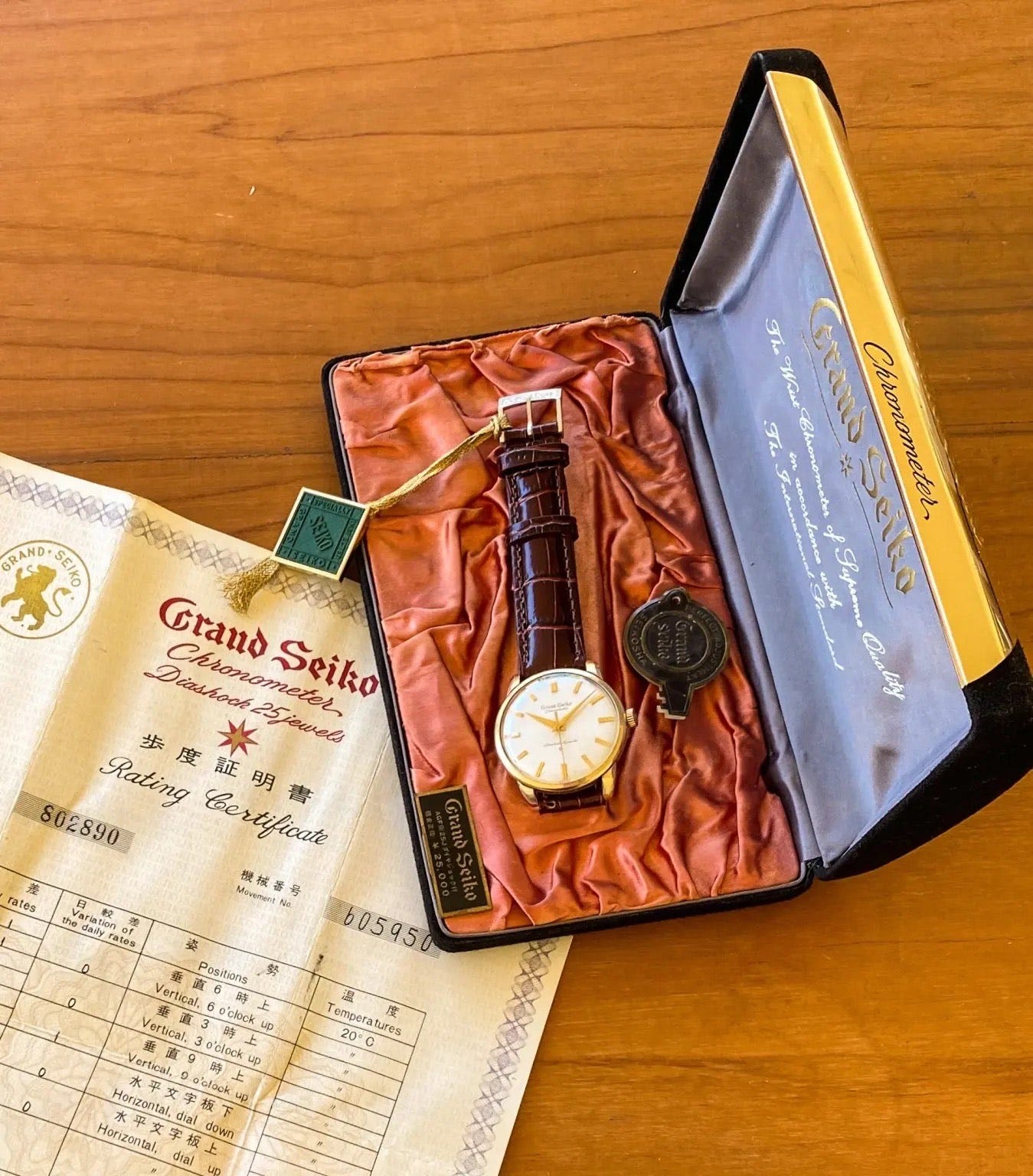
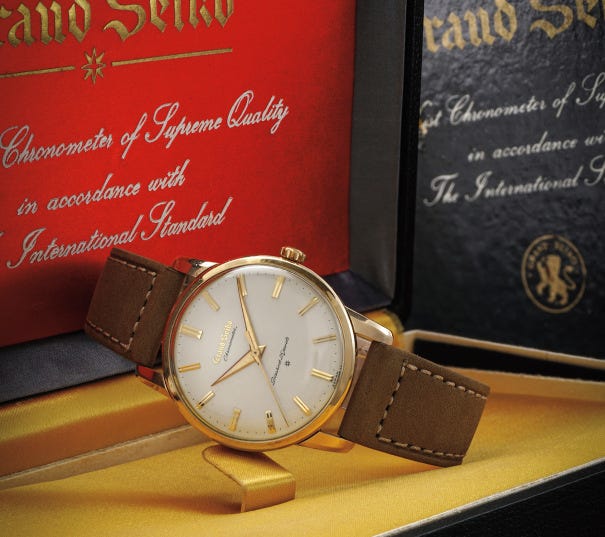


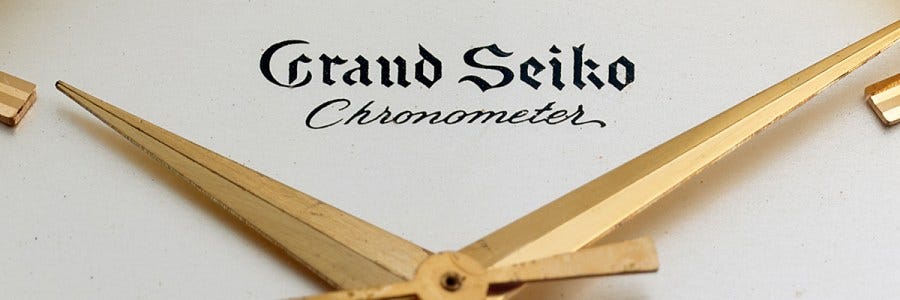
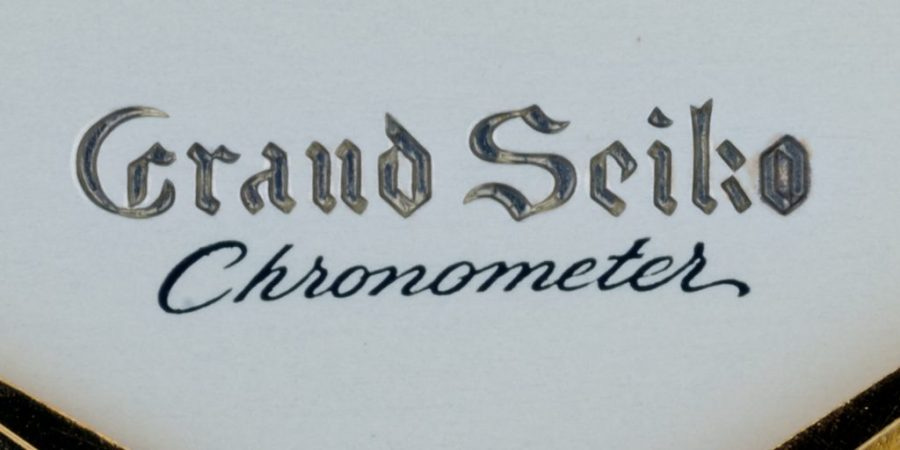
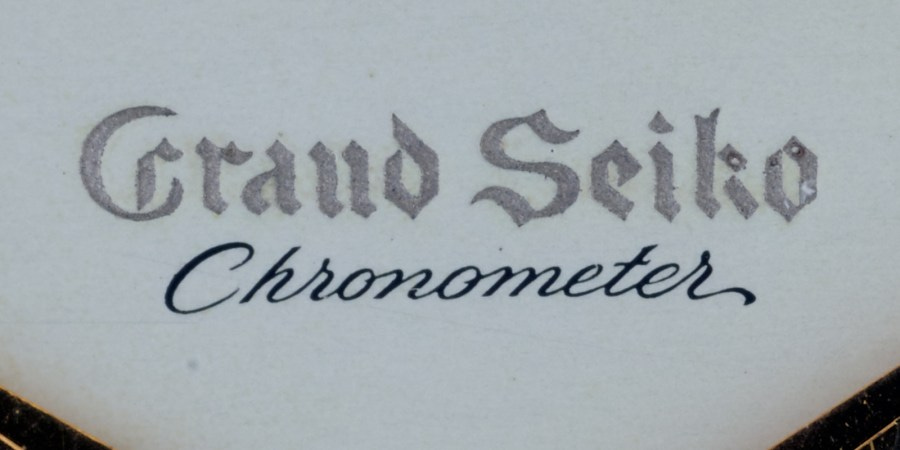
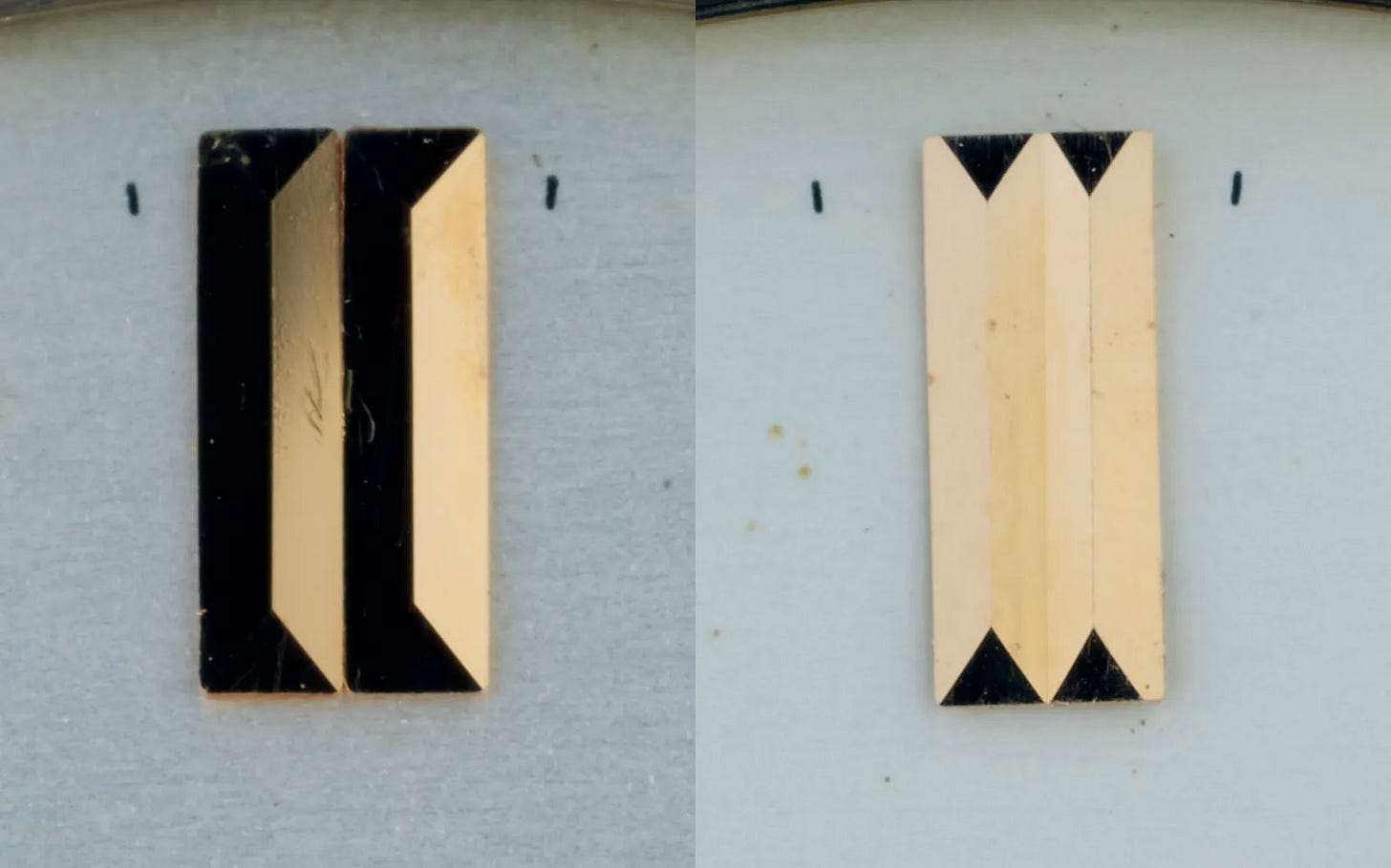
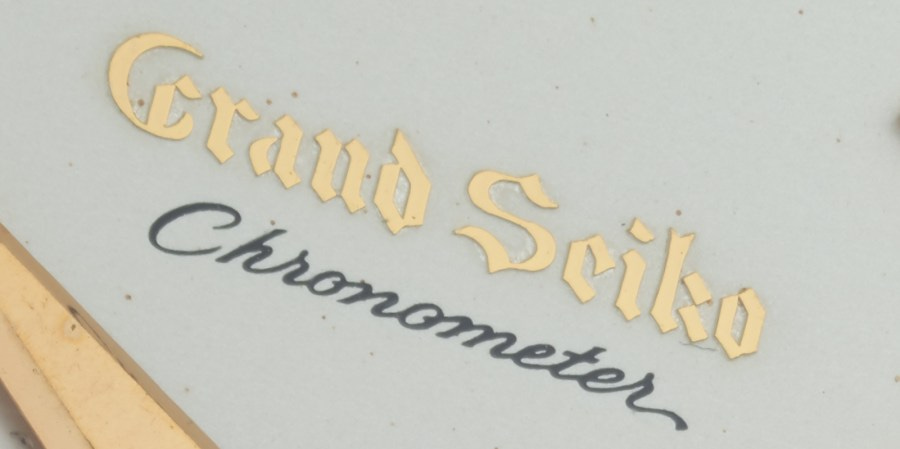
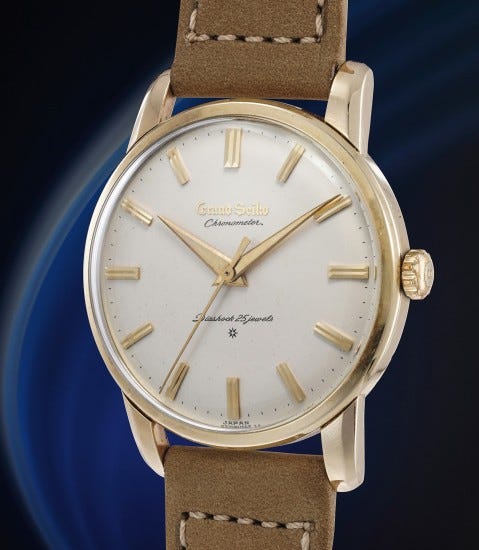
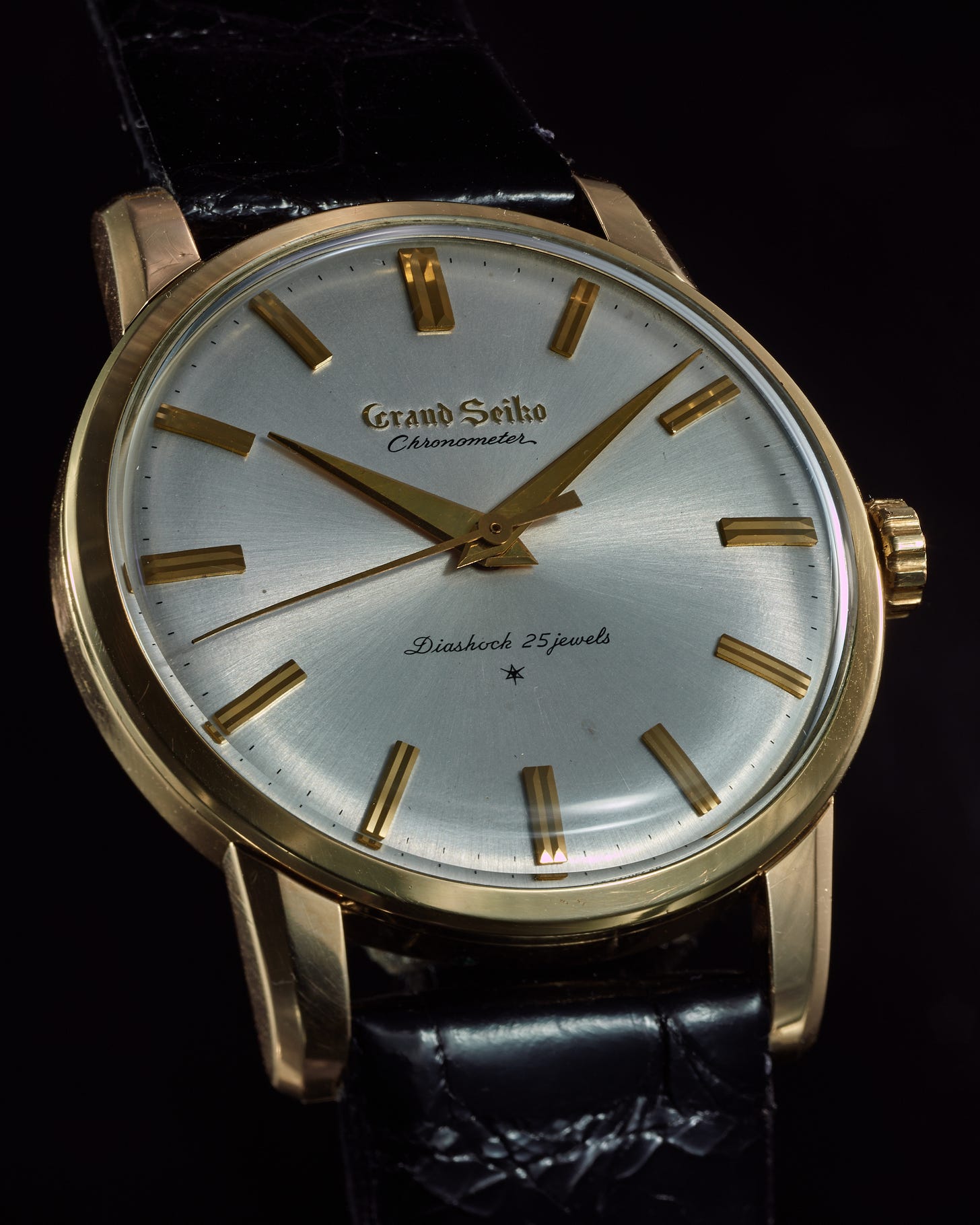
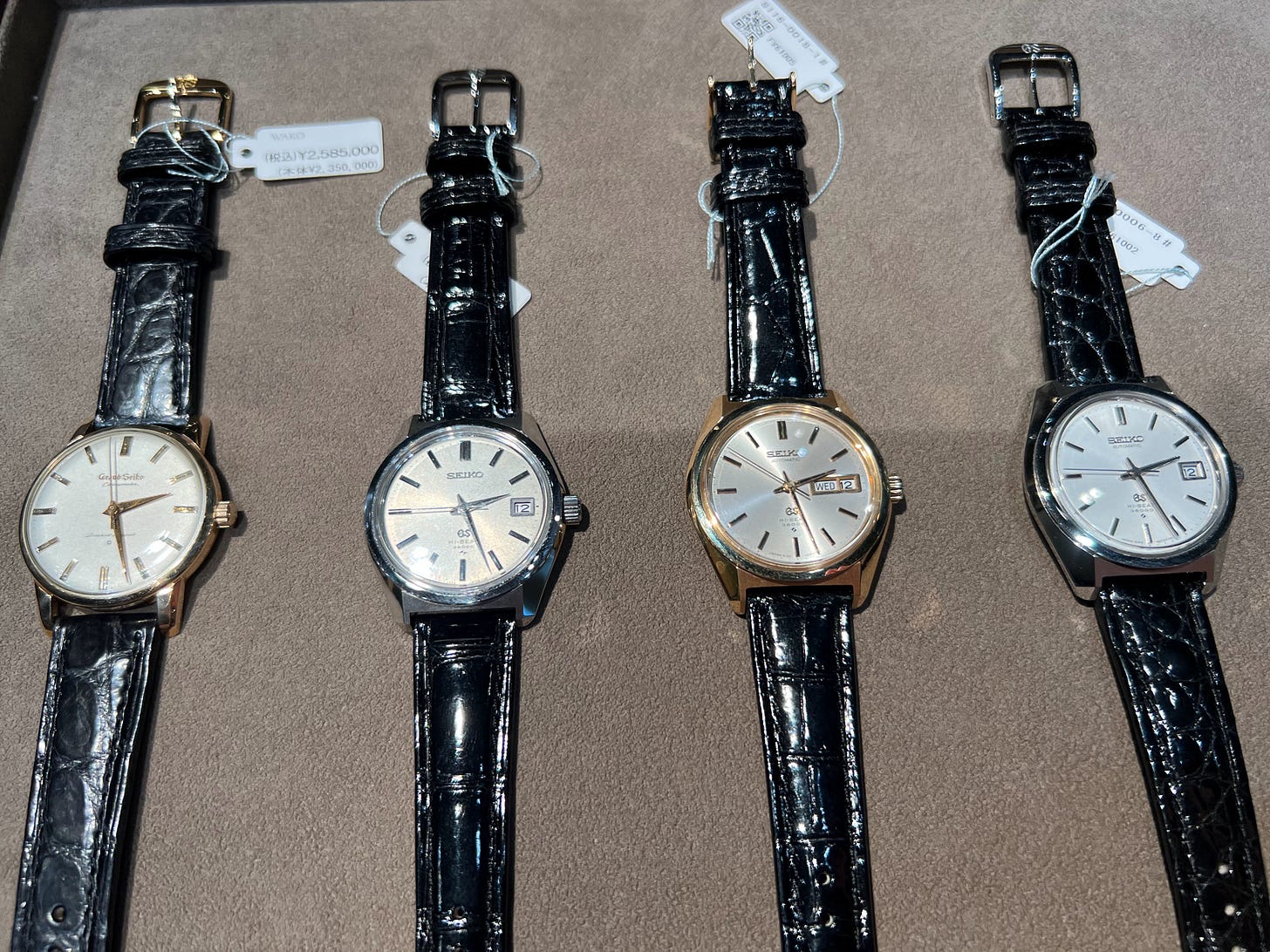

![[Yokohama] Grand Seiko First [Cal.3180] 25 stones with translation_1 [Yokohama] Grand Seiko First [Cal.3180] 25 stones with translation_1](https://substackcdn.com/image/fetch/$s_!B8jq!,w_1456,c_limit,f_auto,q_auto:good,fl_progressive:steep/https%3A%2F%2Fbucketeer-e05bbc84-baa3-437e-9518-adb32be77984.s3.amazonaws.com%2Fpublic%2Fimages%2F9a8c2dd0-4597-42c4-b2f8-8b38cbc7cff2_600x450.jpeg)
8/63 on my AD 😅 thanks Gerald
Gerald! Thanks for this and all the work you put in. Watch-porn at its finest 😃. Just paid my yearly fee and feel that I already got more than my money back from this write up alone. 🙏🏻